Greetings,
After England, Hitomi and I crossed under the chunnel again to Paris where
we stayed for two days before taking the Thalys high speed train to Brussels
and then on to Bruges. We didn't have too many expectations of Belgium, but
it was one of those destinations that pleasantly surprised us. Belgium has good
food and good beers, beautiful medieval cities, great museums, a long history,
and its small size makes it very easy to get around. The longest train journey
between the main cities of Belgium is only about an hour long.
Our first destination was Bruges where we had a lot of trouble finding a place
to stay (even though we tried booking a month in advance). Bruges doesn't have
a lot of budget hotels, although it is filled with B&B's. We tried emailing
all of the ones in the Lonely Planet guidebook which were all full. However,
many of them gave us a list of others to try which we also emailed. Eventually,
we found a place and made a reservation. However, about a week later, the B&B
said that they had made a mistake and were actually full, but that they had
found us a place to stay right across the street. It turned out to be a beautiful
room on the top floor of an old traditional house with nice skylights, lots
of room, a nice bathroom, and great breakfasts.
We enjoyed four days wandering around the small streets of Bruges (in between
soccer matches :-), and did a side trip to the city of Ghent.
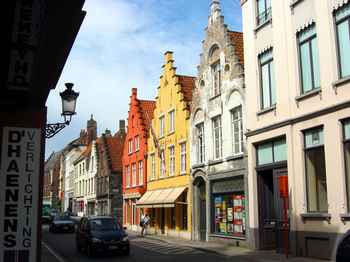 |
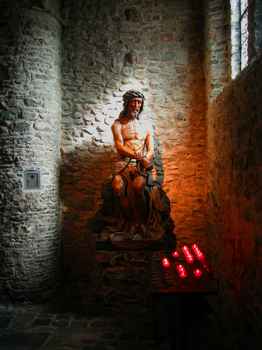 |
| Some typical houses in Bruges. |
Atmospheric lighting in a Bruges cathedral. |
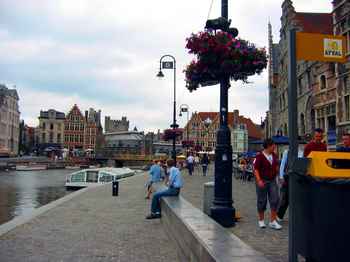 |
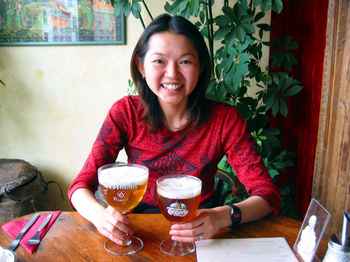 |
| Relaxing in a square in Ghent. |
Enjoying some delicious Belgian beers while
we wait for our Indian curries to arrive. |
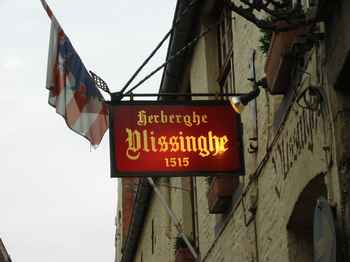 |
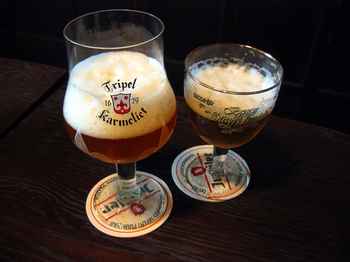 |
| This Bruges bar has indeed been serving
beers since 1515. Maybe we'll come back in a few years for their 500th anniversary
party. |
More delicious Belgian beers. |
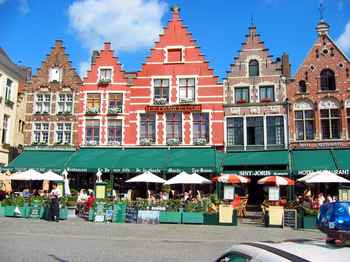 |
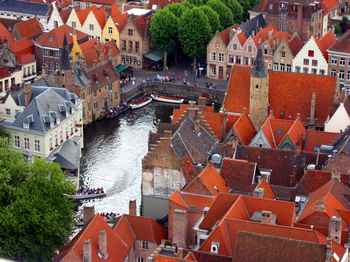 |
| Old guildhouses lining Bruge's main square.
The Belgian towns all seemed to follow a similar pattern with a central
square with the Town Hall on one side, and rows of the very powerful Guildhouses
right next door. |
Looking down from the bell tower on the
canals of Bruges. |
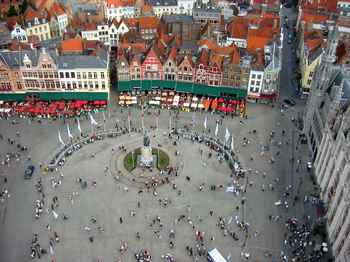 |
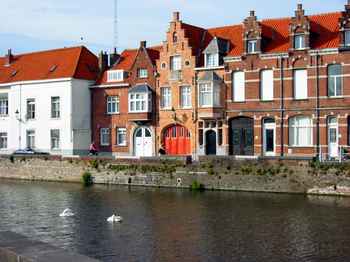 |
| Bruge's main square. |
The canal in the front of our B&B. |
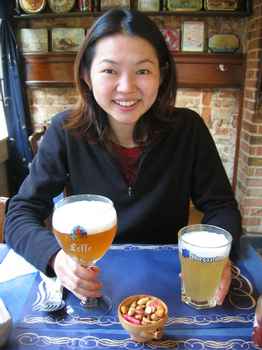 |
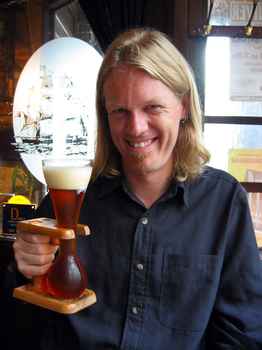 |
| More Belgian beer's. |
I ordered this one because of the interesting
glass, but it was tasty too. There are hundreds of Belgian beers, and each
one has a specific glass that a bar must serve it in. Some bars will give
you the beer for free if it is served in the wrong glass. |
From Bruges, we took a train to Antwerp for a couple of nights. Antwerp isn't
as pretty as Bruges, but it is a lot less touristy and a lot more lively which
made for a pleasant change. We had an interesting B&B where we had our own
kitchen. Our breakfast each morning consisted of a bag left on our doorknob
with some bread, butter, cheeses, and a raw egg that we could cook ourselves.
Our next stop was Brussels where we would be meeting Hitomi's mother. Her mother
was visiting Belgium with some friends for a week, and our itineraries overlapped
for 3 days in Brussels. We arrived in Brussels before her, and the first thing
we did was to head to the Mongolian embassy where we easily got our Mongolian
visas. We paid a slight "express" charge, and received our visas in
less than half an hour.
To continue with our admin, we next headed to a Scandanavian travel agent where
we picked up some tickets for a Norwegian Cruise ship that we had booked four
days on. The ship cruises up the Norwegian coast way up north of the Arctic
circle, and seemed like a great way to see Norway, and to experience 24-hour
sun. That was also painless, and from there we headed into central Brussels
to relax a bit before meeting Hitomi's mother at the airport.
We spent a couple of days visiting the museums of Brussels including some paintings
from the Flemish masters, and a very interesting Art Nouveau museum which is
actually the former home of a well-off turn of the century Belgian. We finished
off our stay in Belgium with a visit to "La Truffe Noire" which is
a Michelin starred restaurant that specializes in black truffles. The host had
a big interest in Japan (was studying Japanese and had his name written in Japanese
on his business card). He took a liking to us, and humoured us by trying to
translate the menu into Japanese for Hitomi's mother and friends. After the
dinner, we said good-bye to Hitomi's mother and the next morning we got on a
train for Amsterdam.
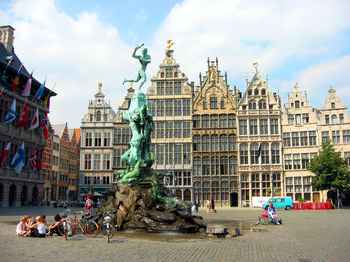 |
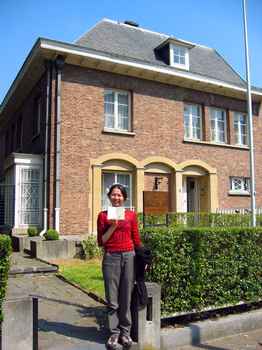 |
| Main square in Antwerp complete with guildhouses
and an interesting fountain. The statue of a man holding a severed hand
relates to a legend that says Antwerp comes from the Flemish words "hand
waving". Apparently the town was founded on the spot where a "giant"
used to charge tolls for boats that crossed his domain, and chop off the
hands of anyone who didn't pay. One day a Roman soldier confronted the giant,
killed him, and severed the giant's hand, which is what this statue is portraying. |
Mongolian embassy in Brussels. Quick and
easy ... a visa in 30 minutes. |
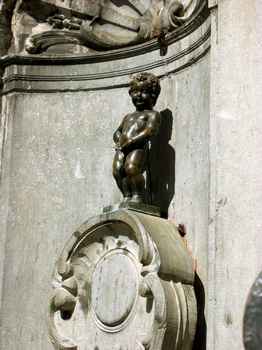 |
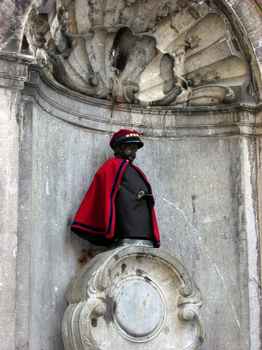 |
| Brussel's famous fountain ... Mannekan Pis.
The statue is about 400 years old and is a copy of an original stone fountain
almost 800 years old. The legend it stands for has been lost over the years,
but that hasn't diminished its popularity. |
He gets dressed up on occasion in one of
his more than 600 uniforms (including Oriental outfits and an amusing Elvis
get-up). |
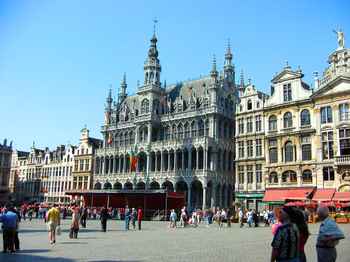 |
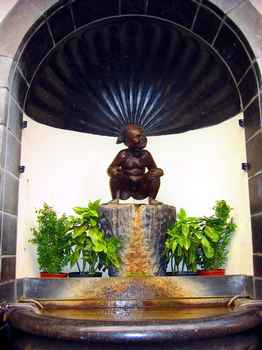 |
| Brussel's main square. |
The controversial "Jeanette Pis"
who was created just 15 years ago and whose existence isn't acknowledged
by the tourist office. |
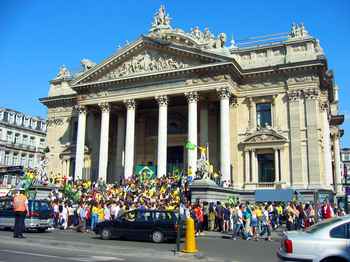 |
 |
| Brazilian fans celebrating their victory
over Turkey. |
More celebrations. |
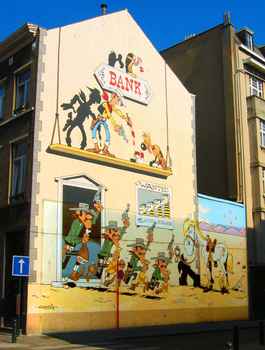 |
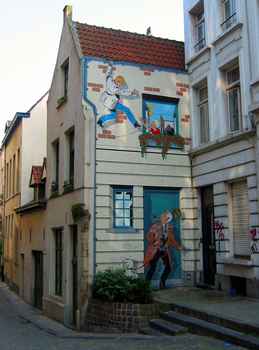 |
| Starting in 1990, Brussels encouraged cartoon
murals to be painted to celebrate Belgium's famous comic heritage. |
I liked this one because it blends in well
with the suroundings. |
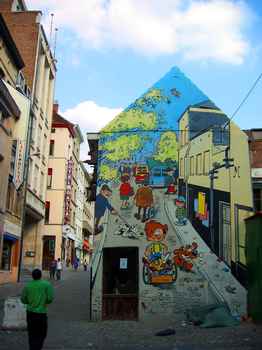 |
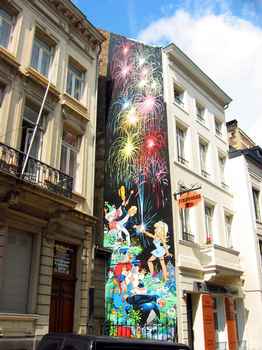 |
| A mural right in front of our hotel. |
A bright and colorful mural. |
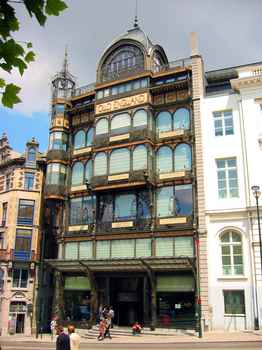 |
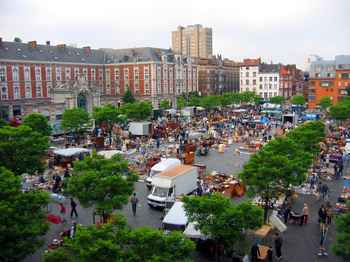 |
| One of Brussel's Art Nouveau buildings (apparently
Brussels was at the leading edge of Art Nouveau at the turn of the century). |
Looking down on a flea market from our hotel
window. |
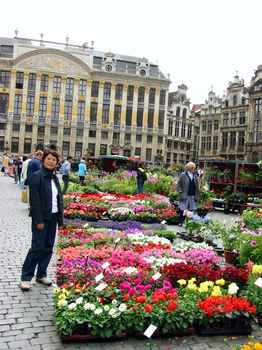 |
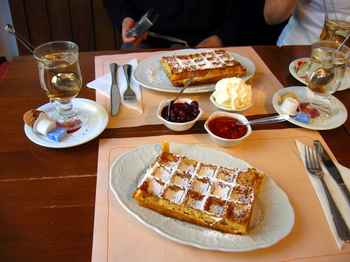 |
| Hitomi's mother at Brussel's flower market. |
Snacking on some Belgian waffles. |
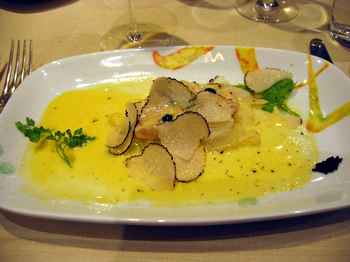 |
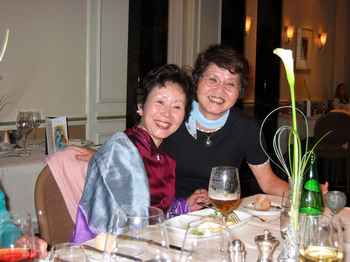 |
| We enjoyed a delicious dinner at the Truffe
Noire which specializes in truffles. The above dish is fish with shaved
truffles. |
Hitomi's mother and her mother's friend
at the Truffe Noire. |
Amsterdam is a fun and lively city, and we had six days to explore it. We had
a nice hotel not too far from the central train station, and were greeted by
our friendly Dutch host who spoke perfect English. We spent our first day strolling
along the canals (trying not to get run over by the hordes of cyclists), and
enjoying some great Indian food. That first night, however, we were woken up
at about three in the morning by an alarm. At first I thought it was a car alarm
set off on the streets outside our window, but it turned out to be the smoke
detector from our building. We got a bit nervous, and I got dressed and started
to look around. There was no sign of a fire, and there were a lot of other guests
that were up. Everyone concluded that the alarm was started by smokers, and
I headed back up to the room, although I wasn't willing to go back to sleep
while the alarm was still sounding. However, after another five minutes or so,
the host showed up and scolded the next-door group of Italians who had been
smoking marijuana (defacto legal in Amsterdam) in their room and set off the
alarm, requiring her to get up in the middle of the night and come to the hotel
to shut the alarm off before the fire trucks arrived. In their defence, the
smoke alarm did seem to go off way too easy. A few days later it went off again
from someone having a steamy shower.
A couple of days later, we went down for breakfast and sat next to the group
of Italians. One started talking to me and said that they had been robbed in
the middle of the night. They hadn't locked their door, and said someone came
into the room and stole their documents and money. The Italians seemed a little
seedy themselves, so I got a little nervous. We quickly went back up to our
room (room 6) to make sure that everything valuable was locked in our packs,
and the Italians (room 5) were trying to get into the room on the other side
of us (room 7) who they had accused of the theft. Needless to say, this un-nerved
us a little. I didn't completely trust the Italians, and wasn't sure what the
real story was. Soon the police arrived and questioned the person in room 7.
However, nothing was found, and I don't think the host was too fond of the Italians
anyways. Thankfully, that day both room 5 and room 7 checked out.
Between all of the excitement at our hotel, we enjoyed walking around Amsterdam,
eating great ethnic food (Indian and Indonesian in particular), and visiting
the Van Gogh museum, the Anne Frank House, and the Rijksmuseum with its famous
Rembrandt paintings. From Amsterdam, we got on a train to Berlin which took
about six hours.
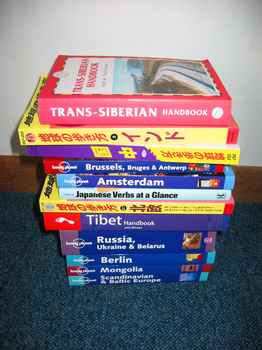 |
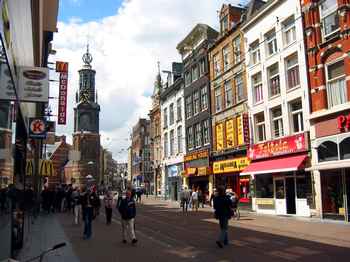 |
| The reason our packs are so heavy. The guidebooks
aren't that easy to find in non-English speaking countries (the Mongolia
and Tibet books were hard to find even in London). So ... for now we are
carrying far too many and doing our best to keep Lonely Planet in business. |
A street in downtown Amsterdam. It is an
amusing medely of old and new buildings with a McDonalds, a casino, a sex
shop, a falafel house, and a Belgian chocolate shop all in sight. |
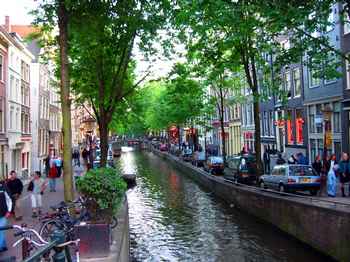 |
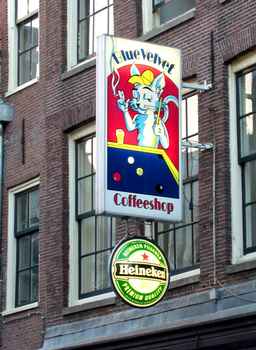 |
| Amsterdam's red-light district. While the
shot would be more interesting taken after dark, the long daylight hours
made it difficult to be "in the right place at the right time". |
Advertising an Amsterdam coffee shop. |
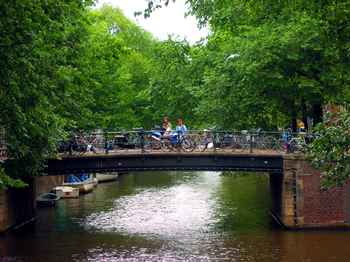 |
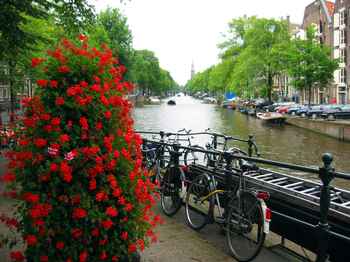 |
| A typical Amsterdam canal. |
Another view of an Amsterdam canal with
the ubiquitous bicycles in the foreground. |
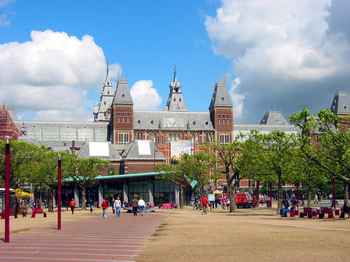 |
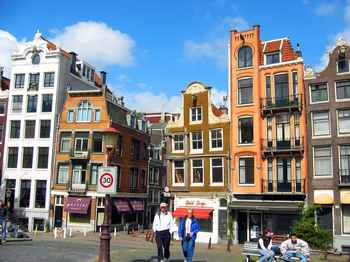 |
| The Rijksmuseum which is home to many of
Rembrandt's masterpieces. |
Amsterdam architecture. It may be harder
to tell in the photo than in real life, but many of these buildings are
seriously leaning ... a side effect of building on land-filled swampland. |
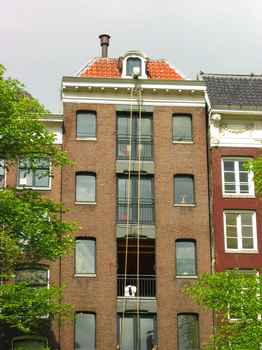 |
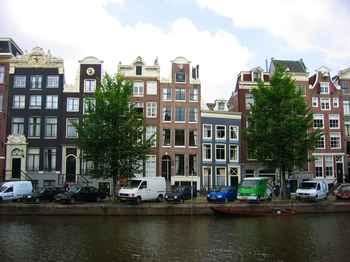 |
| Amsterdam's houses tend to be tall and narrow
with small doors and tiny and very steep staircases. In order to get furniture
into the houses, they are winched up to the appropriate floor and carried
in through the window. |
Another Amsterdam canal. One house in the
middle is seriously leaning. |
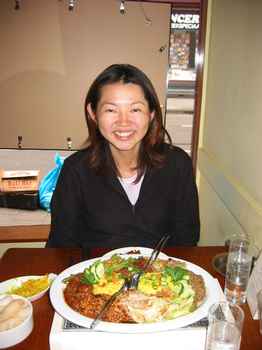 |
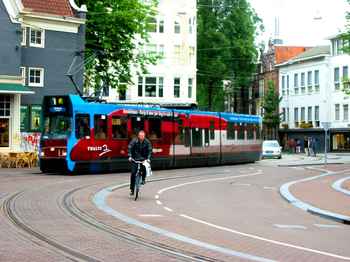 |
| Enjoying a "rice table" at an
Indonesian restaurant in Amsterdam. |
Amsterdam street car. |
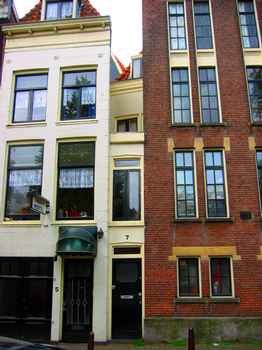 |
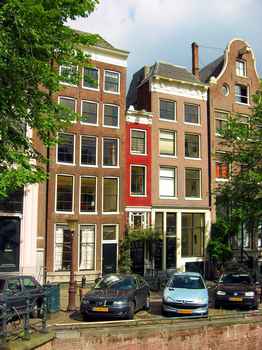 |
| One of Amsterdam's narrowest houses (number
7) in the middle is barely wider than the door. |
Another narrow building. Apparently taxes
were proprotional to the amount of street-front property, encouraging people
to build tall narrow houses. |
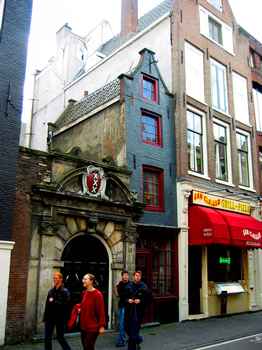 |
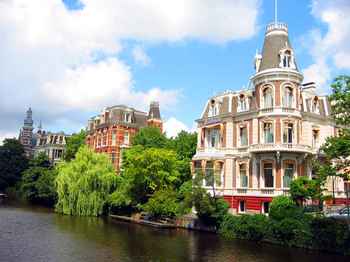 |
| Amsterdam's smallest house. The two narrow
houses mentioned above actually widened in the back. You can see the entire
house in this photo, and each floor is less than 8 square meters (about
80 square feet). |
Another canal view with the Malaysian airlines
office in the foreground. |
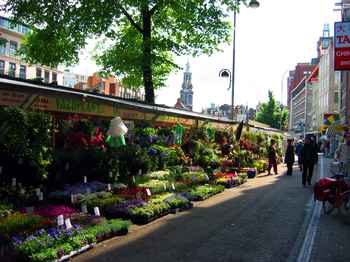 |
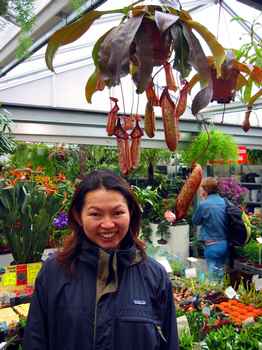 |
| Amsterdam's amazing flower market. |
Hitomi standing under a very healthy carnivorous
pitcher plant. |
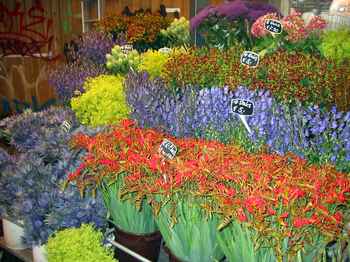 |
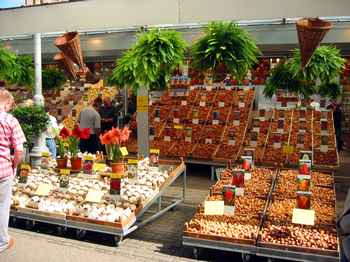 |
| Beautiful flowers. |
Bulbs of all varieties. |
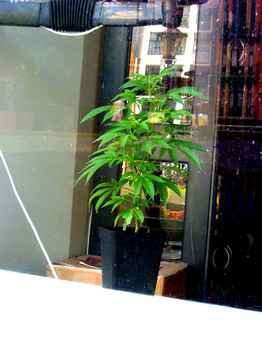 |
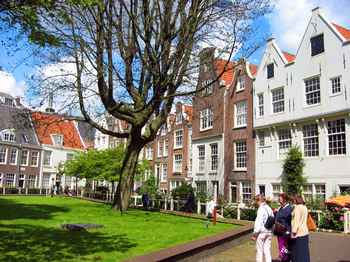 |
| More Amsterdam flora. |
A Catholic convent in the middle of Amsterdam. |
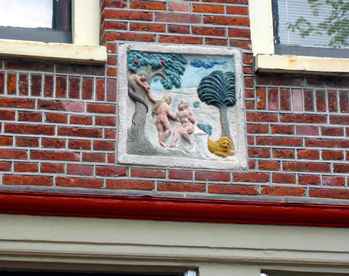 |
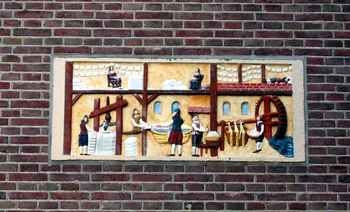 |
| A signpost with Adam and Eve being tempted
by Satan to eat an apple. Apparently, it was used to mark a fruit market. |
Another Amsterdam signpost. In the early
days of the Dutch postal service, apparently these markers were part of
the address (in the days before house numbers were invented). |
I wasn't quite sure what to expect of Berlin, but it both lived up to my expectations
and surprised me. I expected a city that was a lot more concentrated and busy,
and with more of an alternative edge. Instead, the city was a lot more spread
out than I expected with lots of parklands. Our hotel was in the center near
the "Zoo" station from where it was about a 5km walk to the Mitte
section which used to be part of East Germany and has many interesting buildings.
We were able to walk between the two almost entirely in quiet forested parks.
Another surprise of Berlin for me was both how integrated the two halves of
the city had become, but also with how much work was left to do. As you walked
around Berlin, for the most part you couldn't tell which was East and which
was West. The well organized public transportation seamlessly linked all parts
of Berlin, and there were few traces of the wall. At one point, the part of
East Germany bordering the west was filled with watch towers, guard dogs, and
even land mines. All of that has been completely obliterated at this point.
However, despite all that has been done in the past 13 years, Berlin is still
a city under construction. There are cranes everywhere and construction projects
wherever you look. If you wander to Potsdammer Platz which used to be just inside
the East German boundary, you now find a glitzy Sony Center complex complete
with restaurants, bars, and IMAX theaters. However, just behind the Sony Center
are a dozen or so cranes looking to further develop the center of Berlin.
One bit of admin that we wanted to take care of in Berlin was to get the last
visa that we needed for the near future ... a Chinese visa. The huge Chinese
embassy was in downtown Berlin, and we headed there hoping to be able to get
a visa. Unfortunately, we were turned down as the Berlin embassy (and apparently
many Chinese embassies in Europe) only gives visas to local residents. This
is a bit of a pain for us. We couldn't have applied for the visa in the US or
Japan since Chinese visas expire after three months. We had been warned that
this might be the case, so we weren't too disappointed. We just couldn't understand
why they had such a stupid rule. I know that in Asia, the Chinese embassies
don't have such a rule, and I have successfully applied for Chinese visas in
Laos, Mongolia, and Hong Kong in the past. We will be going through Mongolia
on the way to Beijing, so we should be able to get our visa there as well. I
was just hoping to have one less thing to worry about while in Mongolia.
Our time in Amsterdam had been filled with rain, although we were luckier in
Berlin with clear skies and very hot weather. We spent one day eating outdoors
at a Thai restaurant when an Asian couple sat next to us. They looked like locals,
and we were surprised when they started speaking Japanese to each other. It
turns out that the husband works for Asahi TV in Japan, but has been living
in Berlin for the past 20 years. It was interesting to talk to them about their
experiences during the end of the Cold War and the fall of the Berlin Wall.
We talked for about an hour, after which we were invited to their place for
dinner the next night (although the husband would be in Prague for business).
Their house was in the outskirts of Berlin just inside of former East Germany.
It, too, was surrounded by parks, and after a healthy vegetarian dinner, we
went for a pleasant stroll in the countryside (with our hostess collecting "stinging
nettle" to use as a natural pesticide to protect her garden).
On our last day, the weather got really hot, and we visited a German beer garden.
With the heat, the garden was absolutely packed, and it was difficult to find
a seat. Once we did, we were glad we came as we sat under the trees in the park
and enjoyed large mugs of delicious German wheat beer. After five days, our
short stay in Germany was over, and we hopped on a train to Copenhagen (an eight
hour journey including a half hour stop in Hamberg).
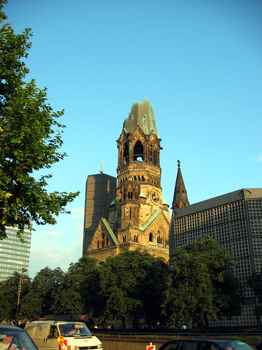 |
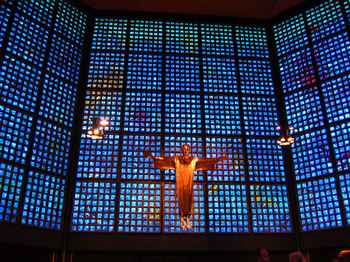 |
| Berlin's bombed out cathedral left largely
unrestored as a sort of museum. |
A modern church that sprung up next to the
older one. |
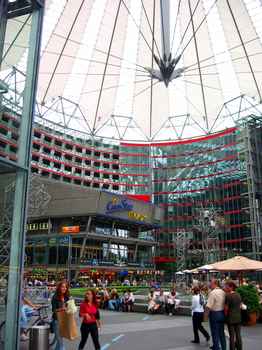 |
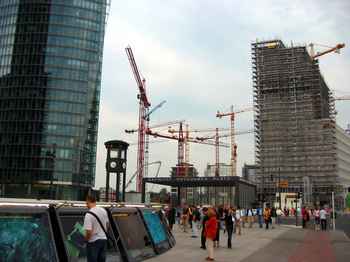 |
| The Sony Center in Potsdammer Platz. |
Its now 13 years since the wall fell, but
the construction in Berlin is far from over. |
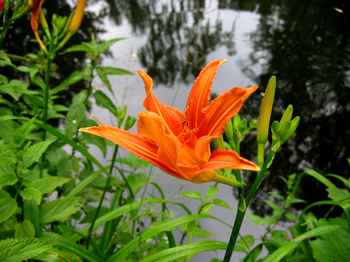 |
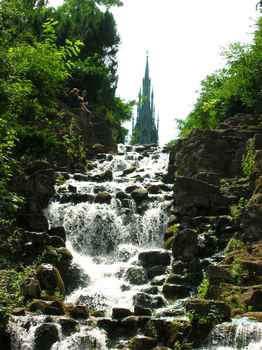 |
| A lily in on of Berlin's many parks. |
A fountain in "Victory Park". |
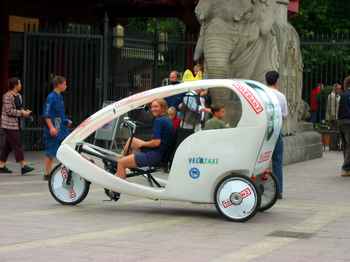 |
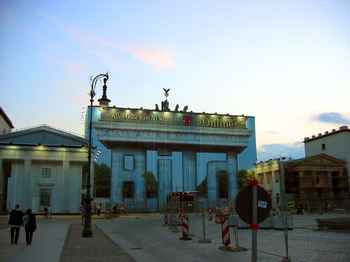 |
| A novel Berlin taxi. |
The Brandenburg gate which used to mark
the east-west border is now under restoration. |
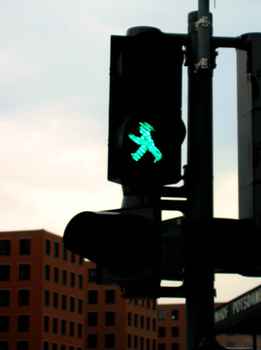 |
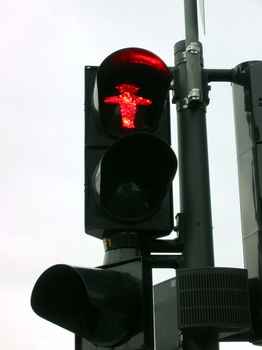 |
| East Berlin walk light. |
East Berlin stop light. |
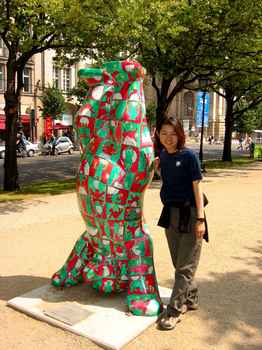 |
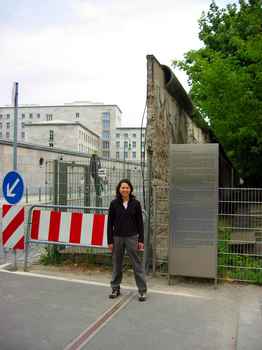 |
| A symbol of Berlin that can be found all
over the city ... the bear. |
Standing with one foot each in former East
and West Germany. One of the few remaining parts of the wall is behind Hitomi. |
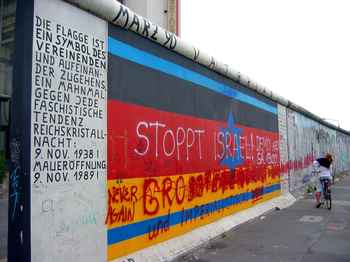 |
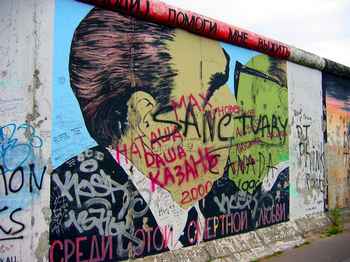 |
| The "East Side Gallery" which
is the largest section of the wall still standing. Already crumbling, sections
have been renovated and there are plans to make it into a sort of open-air
museum. |
Breshnev french-kissing Honecker (the former
leader of East Germany). |
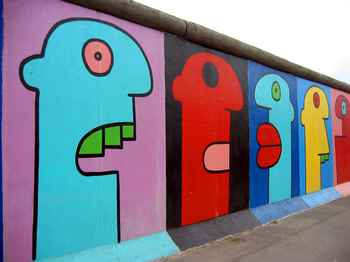 |
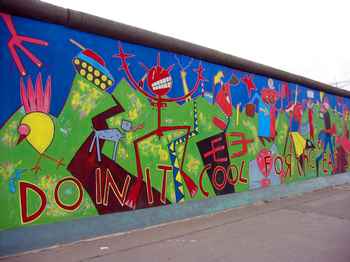 |
| A restored mural. |
Another restored mural. |
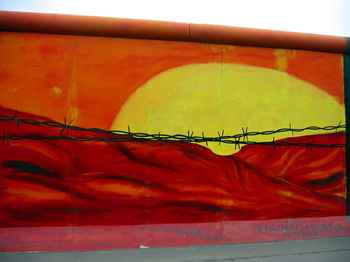 |
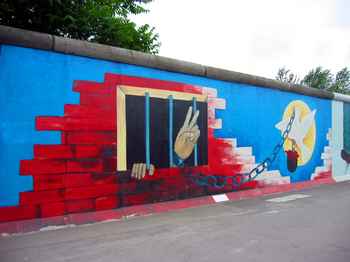 |
| A mural with a more political motif. |
Another interesting mural. |
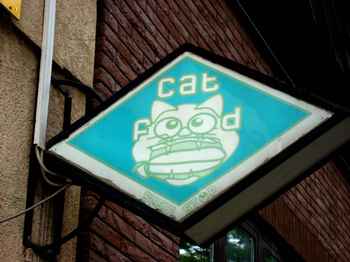 |
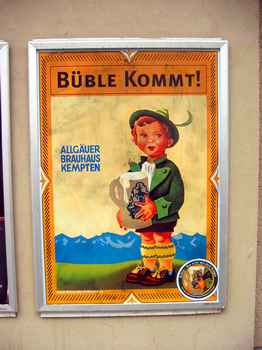 |
| An un-appetizing advertisement for a sushi
shop in Berlin. |
A cute German poster. |
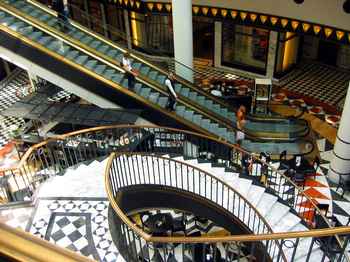 |
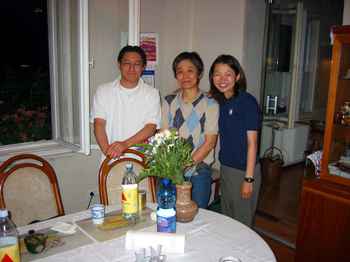 |
| A luxurious shopping mall in former East
Berlin. |
A Japanese family that we met at a Thai
restaurant and that invited us for dinner. |
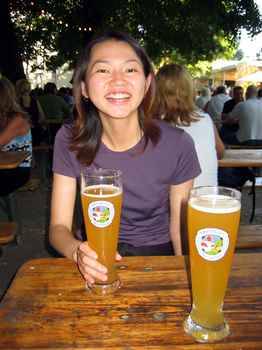 |
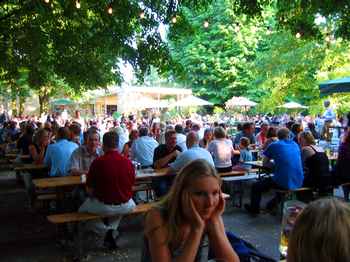 |
| Enjoying a couple of German wheat beers
on a very hot day at a crowded German beer garden. |
Looking out over the beer garden. |
As had been the case in Sicily, the train crossed from Germany to Denmark in
a ferry. We arrived in Denmark late in the afternoon, and wandered the 150m
from the train station to our hotel. The hotel was a budget hotel for Denmark,
although hardly budget for us at almost $70 per night. We didn't have real high
expectations, although we were a little disappointed in the neighbourhood as
we passed through crowds of homeless and drug adicts on the way to our hotel.
Inside our hotel, we had a very basic room with a single dirty bathroom shared
between the 10 rooms on the floor. It reminded me of some rooms we stayed at
in India, although they cost $2 per night and not $70.
However, not wanting to let our surroundings get us down, we headed out past
the train station, back onto the "right side of the tracks", and into
the beautiful center of Copenhagen. A 1.5 km long pedestrian street cuts through
the heart of Copenhagen, terminating at the beautiful Nyhavn canal. As it was
an unseasonably hot day, the Danes were out in hordes enjoying the warm weather,
splurging on very expensive Scandanavian beers, and watching some of the many
street buskers.
We spent the next day on a walking tour through Copenhagen, including a visit
to the statue of the Little Mermaid, as well as a visit to the National Museum
with its amazing collection of Viking artefacts. On the next day, we did a day
trip to visit the town of Hillerod and the nearby Frederiksborg Castle, and
then on to Helsingor which is home to Shakespear's Hamlet (and is right across
the bay from Sweden).
After three nights in Denmark, we took a train to Gothenburg in Sweden and
then on to Oslo in Norway.
We will stay in Oslo for 4 or 5 nights (where we will mail home the laptops),
before heading into the western Fjords for a week or so. From there, we will
connect with the Coastal Steamer in Alesund on July 23, and then sail up far
past the Arctic circle to the northernmost part of Europe at Honningsvag (about
71 degrees latitude), arriving on July 27. For information about the cruise
ship that we will be taking, check out www.hurtigruten.com/uk/index.html.
The midnight sun in Honningsvag lasts until the 29th of July, so we will get
there 2 days before it ends. From Honningsvag, we will travel through Finnish
Lapland down to Helsinki. At this point, we will have traced almost completely
around Sweden without, unfortunately, setting foot inside it (except for 5 minutes
at the Gothenburg train station). We weren't intentionally skipping Sweden,
but it was just the way our itinerary worked out.
From Helsinki, we will be taking a train into Russia on the 5th of August.
We will spend 4 days in St. Petersburg and then 4 days in Moscow before we start
our Trans-Siberian journey. We broke up the journey into four stages. We spend
one night on the train before getting off in the Siberian city of Ekaterinburg
for one night (mostly just to break up the journey and have a shower - there
are none on the trains). We then spend three more nights on the train before
getting of in Irkutsk and spending a couple of days at a homestay on Lake Baikal
(the largest lake in the world and contains 25 percent of the World's supply
of fresh water). As it turns out, this is where we will be spending our first
wedding anniversary (I wonder if there are any nearby 3-star Michelin restaurants?).
From Baikal, we will spend two more nights on the train before arriving in
Ulan Bataar on the morning of the 25th of August. We will spend 8 days or so
in Mongolia (hopefully including a jeep tour of the northern Gobi), before getting
on our last segment of the Trans-Siberian and the 1-day journey which will take
us to Beijing.
From Beijing, we will work our way south through Xian and on to Chengdu. We
will then head as far west towards Tibet as possible where a jeep will meet
us and take us on a 9-day journey through Tibet to Lhasa. We then plan to continue
overland from Lhasa to Kathmandu, and then assuming things remain calm in India,
down into India.
Our days in Europe are quickly coming to an end, and we will soon head into
the less cushy but more exotic lands of Asia. Its all none too soon as well
as Scandanavia is proving hard on the budget. Norway especially is incredibly
expensive. You know somewhere is expensive when we overhear the Japanese tour
groups complaining about how much things cost here. It costs about 70 cents
US to initiate a local phone call, $10 US for a McDonalds happy meal, and the
one Indian restaurant that we looked at charged $30 US just for a curry (you
want rice too? ... thats extra). Even at the youth hostels, it costs about $30
each to stay in a dorm bed (with segregated mens and womens rooms) or $80 to
stay in a double (where you must bring your own sheets or rent them from the
hostel). However, the grocery stores aren't too outrageous, so I think we will
be doing a lot of picnicking. Besides, Norway is a nature destination, and what
better way to enjoy the outdoors than with some bread and cheese and great mountain
views.
I'm not sure when the next trip report will come out ... maybe I'll write it
on paper during the Trans Siberian and send it from Beijing. We'll need something
to do to kill the time :-)
Take care, and keep in touch!
Ron
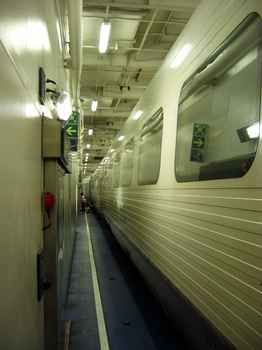 |
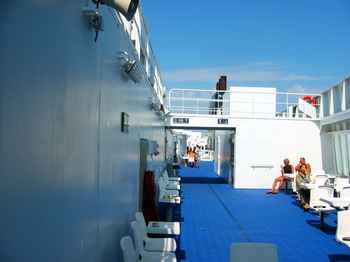 |
| Our Copenhagen bound train sitting on a
ferry. |
Enjoying the sunny weather as the ferry
crosses from Germany to Denmark. |
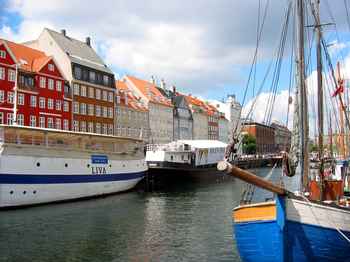 |
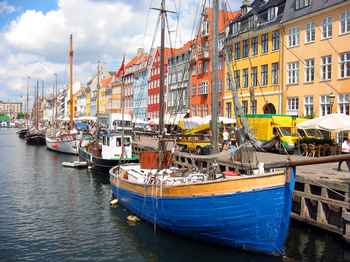 |
| The beautiful Nyhavn canal in Copenhagen. |
Another view of the canal. |
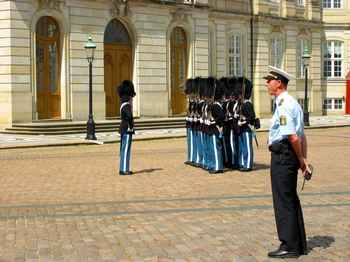 |
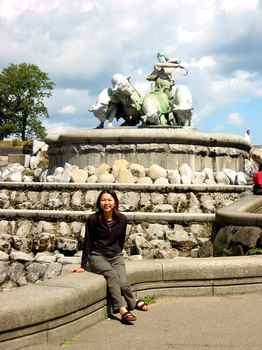 |
| Changing of the guard in Copenhagen. |
Relaxing a bit in front of a fountain (that
has been turned off indefinitely because it leaks too much water). |
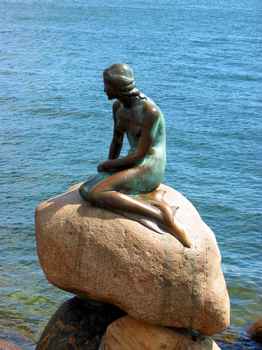 |
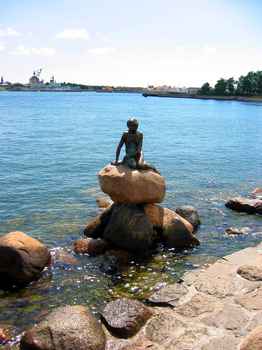 |
| A statue of Hans Christian Andersen's Little
Mermaid. |
Another view of the little mermaid. |
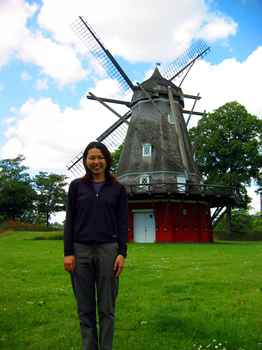 |
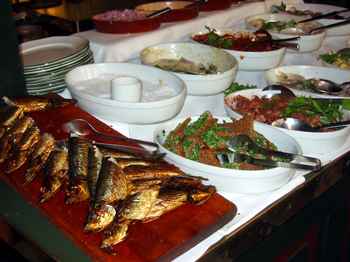 |
| A Danish wind mill. |
Dining out in typical Danish style. This
is an all you can eat herring buffet. The dishes were mostly of the cold
and pickled variety with some tasty warm or smoked ones thrown in. |
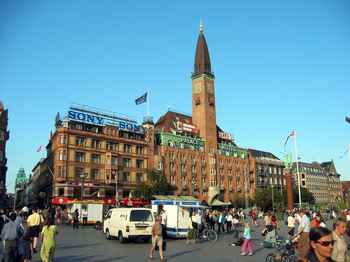 |
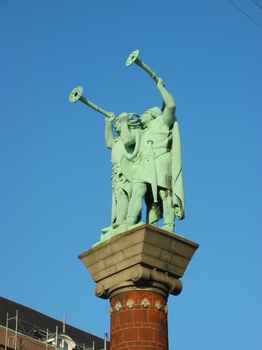 |
| The main square in Copenhagen. |
A statue illustrating a Danish musical instrument
from antiquity. A pair of curved and similarily tuned horns that wrapped
around one's head. |
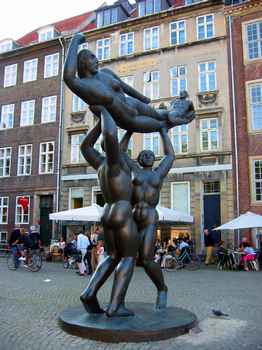 |
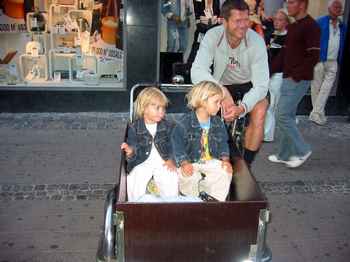 |
| Some modern art. |
Northern Europeans ride a lot of bicycles.
Here, a father pauses with his two daughters to check out a street busker. |
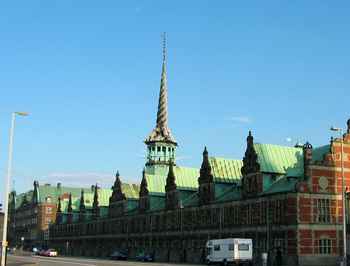 |
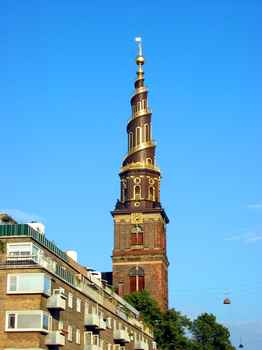 |
| An interesting tower. |
A church with a spiraling tower. |
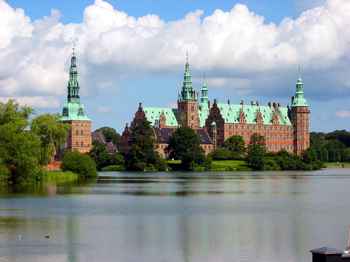 |
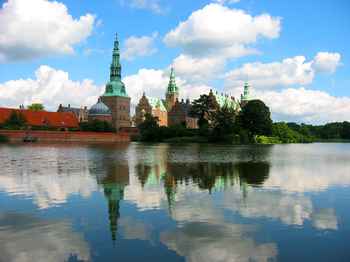 |
| Frederiksborg Castle about 50km outside
of Copenhagen. |
Another view of the castle. |
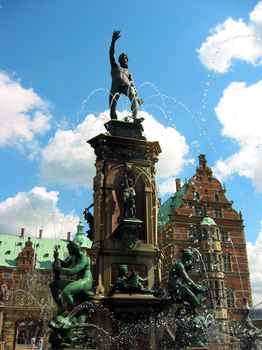 |
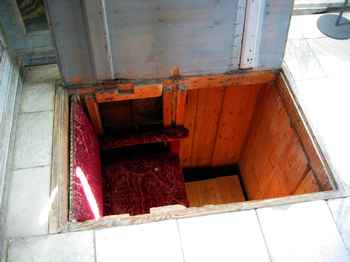 |
| An interesting fountain in front of the
castle. |
A 400-year old elevator. The king would
sit on the chair in this hole in the floor, and his servants would lower
him down to the bottom floor. |
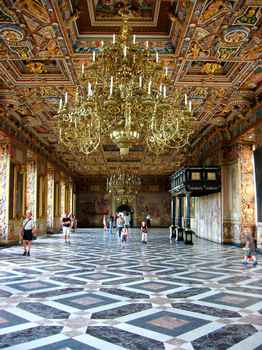 |
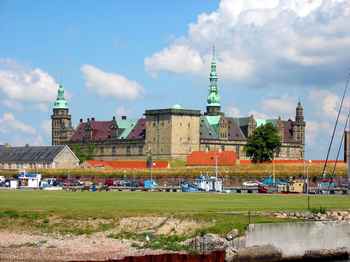 |
| A grand hall in the castle. |
The castle that was supposedly the inspiration
for Shakespear's Hamlet. Apparently, there was a nobel who lived here by
the name of "Amleth", and one theory is that Shakespear just removed
the trailing "h" and added it to the beginning. |









































































